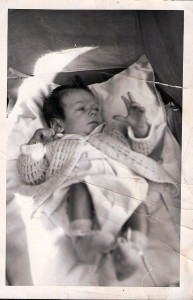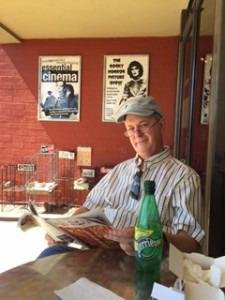 I have a collection of family snapshots scanned into the computer, going back to 1945. It’s mostly pictures of and by me. The traditional photographic records that a family might have going back across the generations, I don’t have and maybe never existed. Photography is a leisure activity not high on the priority list for immigrants and working-class people. My family didn’t take many pictures, and most of the ones we did have were lost in a flood during the 1960’s. I have the salvage from that, plus my own snapshots since then.
I have a collection of family snapshots scanned into the computer, going back to 1945. It’s mostly pictures of and by me. The traditional photographic records that a family might have going back across the generations, I don’t have and maybe never existed. Photography is a leisure activity not high on the priority list for immigrants and working-class people. My family didn’t take many pictures, and most of the ones we did have were lost in a flood during the 1960’s. I have the salvage from that, plus my own snapshots since then.
For young people: photos are called “snapshots” because cameras once had a spring-loaded shutter that really did “snap” when the shutter was released. The disposable film cameras still available in some drugstores work that way even now. The photograph resulting from the snap of the shutter and subsequent exposure and development of the negative film and printing of the positive picture, was metonymously called a snapshot, mainly to distinguish it from a professionally-made, studio photograph. Professional cameras didn’t snap. Many of them went “ka-chunk” as the reflex mirror flipped up during the moment the shutter was open then flapped back down – one of the more highly implausible media technologies ever invented. Today’s digital cameras are virtually silent, though many produce a gratuitous “snap” from a sound generator for auditory feedback.
I took a quick tour of my snapshot collection, sampling here and there, to gain a sense of what I had, thinking that such a large number of pictures could constitute a rich resource for writing something, I knew not what.
What I discovered did not point to any clear writing project. Autobiography would be the obvious thing, but my life story is about as boring as you could get and besides, I have no motivation to recount it. I have to wonder about the motivation of anyone who publishes an autobiography.
Convention dictates that an autobiography is justified in only two situations. One is if you have kids and grandkids who might someday be interested in some details of your life. I have none of those. The second is if you had some interesting effect on society, such as starting a famous company, serving in the Senate, being a movie star, pulling off a great train robbery or flying around the world in a dirigible – something that lifts your story above the humdrum of ordinary everydayness. I have done nothing but the ordinary. I am, and have been, a plain-vanilla white, middle-class, suburban guy groping through confusion, scratching out a living, trying to find meaning in the chaos of experience. I have nothing special to report, and my pictures show that.
My next idea was to use the pictures to tell a fictional story. The people in the pictures would be story characters and I would arrange sequences of pictures into a sort of graphic novel. I could use image-processing software to convert the pictures from fuzzy old photos to line drawings, colored or not.
But looking through the pictures, I realized that they don’t lend themselves to that use. Most of the portrait shots are highly conventional (“Say cheese!”), uninteresting and inert. The characters don’t look remotely like storytellers, let alone actors in a drama. Each picture has its own context, usually conventional (birthday, graduation, vacation, etc.), and doesn’t look like it could be anything other than what it is.
Many pictures, maybe half, don’t even have people in them (cars, boats, buildings, cityscapes, flowers, sunsets, kittens). Those objects might actually be the better choices to equip with speech balloons to tell a story, but that idea made me realize two shortcomings of this approach. One, the story would have to be told, not shown, and as pure narrative exposition, that would probably be boring. And two, what contribution would the pictures make? Virtually none. So ditch the pictures and just tell the story.
After five days of study, fifteen pages of notes, and much convoluted thinking, I came to some conclusions. Here are a few.
1. Nobody cares about anybody else’s snapshots, life, or autobiography, so the picture collection is a non-starter for use as a historical record.
2. Vernacular snapshots like mine, as opposed to artistic photos by Annie Liebovitz, don’t contain much information. An anonymous person (anonymous to anyone but me), grinning stupidly into the lens is not informative. The meaning in the photos is almost entirely in my head, my imagination, my memory.
3. When people share family snapshots with others (which they never should do), the impulse is to “explain” the meaning that doesn’t show in the image. “This was my first car.” “That was the time we went to New York.” The context of the picture is the meaning. The image can stimulate mnemonic meaning for the owner of the snapshots, but is wasted on anyone else.
4. The impulse for taking a picture is to address future history. There are no photographs of the future. All pictures are of the past. That’s true even in the moment right after you take them. Subconsciously however, we expect there to be a future, one in which we will look back on the present moment and seek “proof” of how we were, against the vagaries of standalone recall. We don’t think about it in those terms but taking a picture is about the future, not the present.
5. Taking a picture is also about stopping time. We conceptualize a moment out of the stream of ordinary experience and recognize it as somehow special. “Take a picture!” someone cries. The urge is to stop the clock, preserve the moment, record the experience, none of which a picture really can do, but that’s what we ask of it. And to the extent that the picture is successful in “capturing” the moment, it is a lie, because life is a process. A static moment from the flow of experience is as representative of it as a dot is of a line.
6. Viewing snapshots is an entirely different process than taking them. Pictures viewed are mnemonics that blend personal and social history. What counts as “an event” worthy of a photograph is defined by social convention, which is why snapshots are unrelentingly conventional. An individual participates in the larger social meaning by enacting the conventional event, even if only subconsciously. That gives the sense, in retrospect of continuity and connectedness with the social order of history. That’s why we have so many wedding and graduation pictures. Most snapshots, therefore, even the personal ones, are not even personal.
7. What makes my pictures mine? What if I went to a flea market and bought a few dozen snapshots of people I didn’t know? They’re very cheap, and for the most part, they look not dissimilar from my snapshots. What is the difference? Only that I recognize and can usually name the people and places in my snapshots. Other than that, there’s little objective difference. What makes my pictures mine is my experience, not anything that’s in the photos themselves.
8. Despite the ubiquity and banality of vernacular snapshots, they still contain many layers of magic and deep mystery that can barely be fathomed. For example, a picture proves that time passes. Of course we knew that, but you don’t feel it passing. It slithers silently by. The picture documents that reality and despite its obviousness, it is still damned mysterious. How does that happen? When did it happen? Ageing is the same. And implicit in the concept of ageing is the long, bumpy ride of psychological development with death looming at the end. Nothing is more mysterious than that. Except maybe the strange sense of self-alienation when looking at a picture of yourself. When I do that, I might be able to recover, a little, the feeling of what it was like at that moment, but for most pictures, that is entirely gone. I was a different person then. It wasn’t me. Except that it was. How can it be me and yet not me?
These are just a few of the puzzles and conundrums I uncovered in examination of my photo collection. In the end, I’m not sure if the collection is a valuable resource for writing or not. Certainly there are plenty of questions that could stimulate introspective stories, but that doesn’t light my fire.
 I reread my notes on Swann’s Way, Volume one of Proust’s novel, In Search of Lost Time. I read reviews of several scholarly books on the topic of “memory studies,” a field that likes to analyze the social meaning of photographs. And I wrote five thousand words of notes. And I still have nothing. So, much to my surprise, this may not be the basis for a project after all.
I reread my notes on Swann’s Way, Volume one of Proust’s novel, In Search of Lost Time. I read reviews of several scholarly books on the topic of “memory studies,” a field that likes to analyze the social meaning of photographs. And I wrote five thousand words of notes. And I still have nothing. So, much to my surprise, this may not be the basis for a project after all.
I’ll let it marinate for a few months and see if anything else emerges.
Graphics: Top – How I started out. Bottom – How I Turned out (so far).
